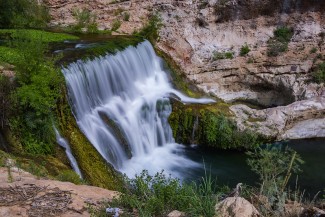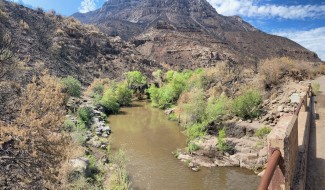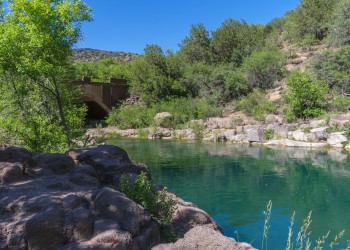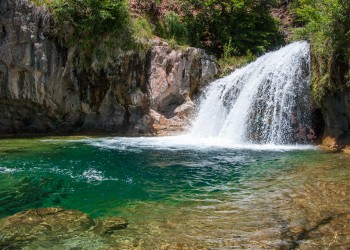Fossil Creek
Blue-green waters pool beneath a crystal-clear, roaring waterfall. Lush riparian growth lines the river's lapping banks, and colorful birds dart back-and-forth overhead.
Yes, you're still in Arizona.
Welcome to Fossil Creek.
Recreation Opportunities
There are 10 recreation sites and trails located along the Fossil Creek Wild and Scenic River. These sites offer opportunities for swimming, sunbathing, fishing, hiking, and more.
Visit Fossil Creek
The Fossil Creek waterfall sits inside a permitted area of the Coconino and Tonto national forests. Parking is limited, and permits may be required. Learn more about the permitting process and how to visit.
History and Geology
Fossil Creek is one of two Wild and Scenic Rivers in Arizona. It is fed by springs that descend from the cliffs of the Mogollon Rim. More than 30 million gallons of water are discharged each day at a temperature of about 70° Fahrenheit. The high mineral content of the water leaves travertine dams and deposits along the river, giving rise to a fossil-like appearance.
Tribal Importance
The Fossil Creek area is recognized as an ancestral homeland of the Apache and Yavapai people of the Verde Valley, who lived along Fossil Creek for generations. Fossil Creek has a number of Dilzhé’é (Western Apache) cultural sites located alongside the river.
A Utilities Powerhouse

The current day Irving Flume site located along the creek was once the site of a power plant.
The Childs-Irving hydroelectric facilities were built alongside Fossil Creek around 1912. The facilities, built by Arizona Power Company (now a part of Arizona Public Service) provided power to local mining communities throughout the 20th century.
The buildings, flume, diversion dam and other structures were decommissioned and removed by APS between 2005 and 2008, restoring full flow to Fossil Creek. However, foundations, flume footings and other bits of the historic structures — including a portion of the old Fossil Creek dam — remain and can be seen in the open area on the north side of the creek.
The Purple Mountain area was originally a 1908 camp for workers who constructed the hydroelectric power plant facilities.
Homesteading
The aptly named Homestead site, now primarily used as a day-use picnic area, was the site of a working homestead up until 1990. The only remaining evidence of this property is a rock root cellar, several sections of water pipe, and the remnants of an orchard. Four pomegranate trees and a fig tree still stand in the Homestead area.
The Backbone Fire

The 2021 Backbone Fire heavily damaged the Fossil Creek area. A Type 1 Incident Management Team (IMT) and a Burned Area Emergency Response (BAER) responded to the fire, working to contain and suppress the fire before stabilizing the area to prepare for long-term area rehabilitation.
Management
Fossil Creek's Management Plan

The management of Fossil Creek is outlined in a Comprehensive River Management Plan as required by the Wild and Scenic Rivers Act. More information about how we manage Fossil Creek — and the entirety of the Coconino — is available in our Forest Plan.








